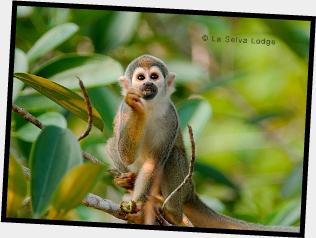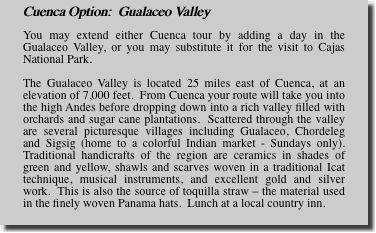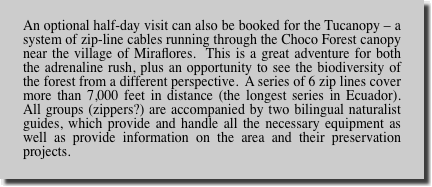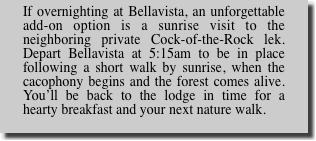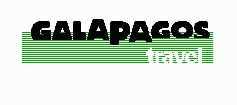 |
|||||||||
Ecuador Mainland excursions
from GALAPAGOS TRAVEL |
|||||||||
 |
|||||||||
About Our: About: Natural History of the Galápagos Special Stuff: Special Trips: |
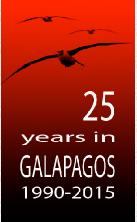 |
||||||||
Mainland Ecuador All of our Galápagos programs go through Quito in mainland Ecuador. Three U.S. carriers fly into Quito: American Airlines, United & Delta. There are also a number of Latin American carriers to choose from, including LAN, Copa & LACSA. If coming from Europe there are flights on either Iberia or KLM. Upon your arrival in Ecuador, an employee of our associate company, GALAPAGOS TRAVEL PROINVERTUR CIA. LTD, meets you at the airport and takes you to your conveniently located downtown hotel. They will also reconfirm your return flights, provide all airport transfer services out of Quito, and are always there to provide assistance and guidance. This includes extension trips in mainland Ecuador. Quito, the capital of Ecuador, is a quiet, beautiful city. Flanked by the tall, snowcapped peaks of the Andes, Quito itself is at 9300 ft, yet located almost directly on the equator. On a clear day, you can see the snow cones of the volcanic peaks, giving the city an air of a mountain retreat. Based on your expectations of a bustling South American city, the serenity and the dramatic setting take you by pleasant surprise. While the population of Quito is over a million, making it the second largest city in Ecuador (Guayaquil is the largest), it has a tranquil small town feel to it (the rush hour and center-city traffic notwithstanding). The people, the city, and the setting seem to blend together, all part of the rich artistic and cultural heritage. All itineraries include one free day in Quito, typically on your return from the Galapagos Islands. Many visitors take the opportunity to extend their stay by a couple of days, or even a couple of weeks. With Quito as your base, we offer a number of half-day, full-day, and multi-day guided extension trips. These are private or small group tours - never big bus tours. The more time you have, the greater the number of possibilities... |
|||||||||
|
||||||||||||||||||||
HIGHLIGHTS OF ECUADOR The following tour selections include half-day, full-day, and multi-day mainland tour possibilities. The more time you have, the greater the number of possibilities, including tours of the Andean Highlands, Indian Markets, and the Amazon; from natural history, to bird watching to adventure trips. Speaking of birds, there are nearly 1600 species to be found in this little gem of a country. One of the delights of Ecuador is the incredible diversity that is found here - diversity in habitats, flora, fauna, cultures... all in a country roughly the size of the state of Oregon. With Quito as your base it is possible within just a couple of hours to be hiking through lush cloud forests, trekking up active volcanoes, birding the high paramo landscape, shopping colorful Indian markets, or even relaxing at a top-rated spa. With all the major roads radiating out from Quito, the following tour options are divided by areas on the compass. Most tours (excluding jungle and cloud forest lodges, and some adventure tours) are private excursions for just your Galápagos group. Most include a private vehicle, driver & guide. Many can be completely customized depending on your interests While it is possible to book many day tours locally in Quito after your arrival, we suggest booking prior to departure (at times it is impossible to find guides at short notice - in addition the best guides and accommodations tend to book up early). We are more than happy to work with you in creating an itinerary prior to your departure, suited to your interests and schedule. We have toured the mainland ourselves and are ready to answer any questions you might have. |
||
QUITO Here at the foot of Mt. Pichincha (15,700 ft), an active volcano, you are in the Andean highlands in what was once an Inca city. When the approaching conquistadors finally fought their way here in 1534, they found Quito in ruins - the Incas chose to destroy their city rather than surrender it. The city was rebuilt in grand colonial style architecture. UNESCO formally recognized this legacy in 1978, proclaiming colonial Quito a World Heritage Site. Thus entering the historical center, or “Old Town” as it is called, and walking down the narrow, winding cobblestone streets, one is immediately immersed in 16th century colonial architecture, by whitewashed walls, red-tiled roofs, heavy wooden doors, and fountained courtyards. Starting at the Plaza de Independencia, a tour of Old Town takes in the Palacio Municipal (City Hall), Palacio de Gobierno (the Presidential offices), La Catedral (the site of the first church in Quito), and Palacio Arzobispal (the Archbishop's Palace), now a series of shops. Nearby is the most impressive architectural treasure Quito has to offer, La Compañia Church, whose interior is a virtual blaze of gold - it is decorated in renaissance style, and almost entirely in gold leaf - it is truly amazing! Also visit the Church of San Francisco (the largest of Quito's 86 churches). Your tour will also include a visit to Panecillo Hill, where the 148 foot tall Virgin of Quito statue commands the best panoramic views of the city. Beyond the core of Old Town Quito there is still so much more see though. A longer tour will open still more doors to the history and culture of Quito… The neo-gothic Basilica and its towering spires are built almost entirely from locally quarried stone. The roof is ringed by elaborately carved gargoyles representing the national fauna of Ecuador. The Archaeological Museum of the Banco Central houses the most complete collection of pieces from Ecuadorian prehistory, dating back to 12,000 B.C. Beautiful exhibits include everything from arrowheads to early ceramics, through Inca artifacts (including gold pieces and jewelry), to 20th-century paintings and sculpture. (closed Mondays) Located 15 miles north of Quito at latitude 0°00'00", La Mitad del Mundo (The Center of the World) is one of the most important geographical landmarks in South America. It's customary to have your picture taken straddling the northern and southern hemispheres; with the drifting clouds and the beautiful mountain scenery in the background. The interior of the monument is a very nicely done Ethnographic Museum – that alone is worth the trip. In addition there is a section describing the 18th century French/ Spanish geological expedition that established the exact location of the equator. Quito's newest attraction is the TelefériQo – a sky tram that takes passengers on a dizzying ascent almost 2 miles up the flanks of Volcán Pichincha, to the top of Cruz Loma. Views from the top (nearly 13,500 feet) are spectacular, out over Quito and the surrounding mountains and valleys. The Vivarium de Quito is a small herpetological research center housing a collection of mostly native amphibians and reptiles. This is your chance to get up close to jungle frogs, or maybe a poisonous snake or boa (from the other side of a glass wall, that is). Quito is also home to quite a number of wonderful art galleries as well. The three most famous galleries are Olga Fisch, Galería Latina, and Oswaldo Guayasamin. |
||
 |
||||||
QUITO TOURS: Colonial Quito (full-day) Colonial Quito (half-day) |
||||||
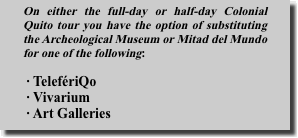 |
||||||
Equatorial Monument / La Mitad del Mundo (half-day) Jacchigua Folkloric Ballet |
||||||
|
||||||||||||||||||||||||||||
|
|||||||||||||||||||||||||||||||||||||||||||||||||||||||||||||||||||||||||||||||||||
|
||||||||||||||||||||||||||||||||||||||||||||||||||||||||||||||||||||||||||||||||||||||||||||||||||||||||||||||||||||||||||||||
 |
||
|
||||||||||||||||||||||||||||||||
COASTAL Guayaquil Tour Options: |
||
Create your own adventure… We are happy to help you design a custom adventure just the way you like it. You might begin with some of our side tours, then add other sights or activities you’re interested in. Maybe join two or more extensions or regions together, and do away with some of the driving (and hotel nights in Quito). Visit one of Ecuador’s flower growers – sure! Heard good things about a different jungle lodge and want to check it out – no problem! Summiting Mt. Cotopaxi or Chimborazo – cold, but doable! Intensive one-on-one Spanish classes – si! Want a bit less structure and a bit more free time on the tours – easy! Whatever you are looking for, we’ve probably done it before and are happy to help you put it together if at all possible. We encourage you to think outside the brochure – it’s your vacation so spend your time how you would really like! |
||
 |
||
|
||||||||||||||||||||||||||||||||||||||||||
|
||||||||||||||||||||||||||||||||||||||||||||||||||||||||||||||||||
